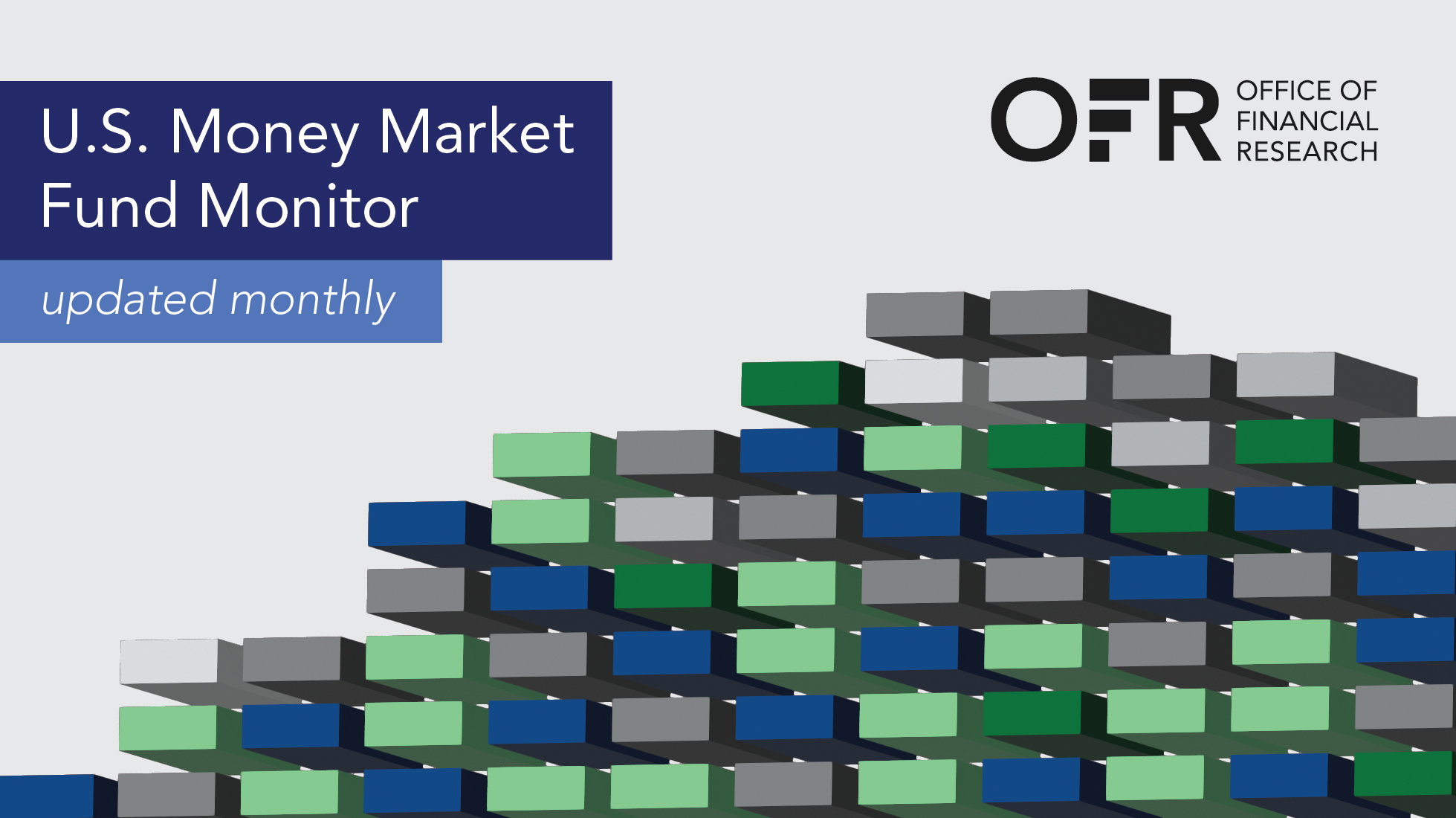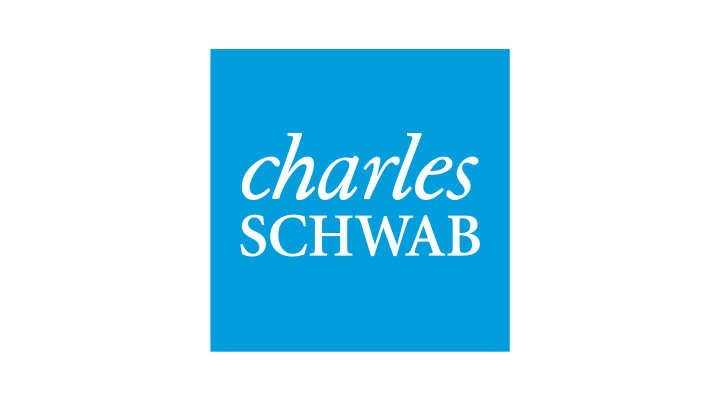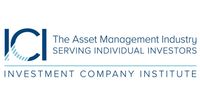Explore web search results related to this domain and discover relevant information.
This monitor is designed to track the investment portfolios of money market funds by funds' asset types, investments in different countries, counterparties, and other characteristics.
This monitor is designed to track the investment portfolios of money market funds by funds' asset types, investments in different countries, counterparties, and other characteristics. Users can view trends and developments across the MMF industry. Data are downloadable and displayed in six interactive charts.U.S. MMFs’ investments by fund category · Investments by U.S. prime MMFs · U.S. MMFs’ investments in the repo marketSee more: OFR's Repo Market Reference Guide · To drill down to this level click 'details' next to an item above. MMFs report their category in Form N-MFP by choosing from several options: ... Other Tax Exempt The OFR's MMF Monitor combines Treasury, Government/Agency and Exempt Government categories into the "Government" category. These funds invest most of their assets in cash, government securities, and repurchase agreements (repos) backed by these securities.The fund invests that cash in short-term debt securities from issuers such as banks, nonfinancial corporations, municipalities and federal and local governments. Money market funds typically rely upon third parties to carry out business activities, such as an investment manager, administrator, custodian, principal underwriter, and transfer agent.

Make your cash go further with a Schwab money fund. Choose from Schwab’s suite of high-yield cash management solutions.
Money market funds are available primarily as mutual funds, but Schwab also offers one exchange traded fund (ETF). Money market ETFs offer the same investment strategy as many money market mutual funds but trade on an exchange at market price.This fund invests in short-term U.S. government debt securities with holdings in U.S. Treasury obligations or repurchase agreements. Shares of the fund are listed on a national securities exchange and trade at market prices.Explore the details of Schwab Money Funds and Schwab Money Funds Commentary. Schwab has eliminated sweep money market funds as a cash feature for most new and existing accounts. Limited accounts and account types may be eligible to have a money market fund as the designated cash feature.Retail Investors may also choose to invest in these funds. Both Retail and Institutional Investors are eligible to invest in government money market funds.

U.S. money market funds have reached a record high of over $7 trillion, potentially setting the stage for investments in riskier assets like crypto. Plus, Ledger CTO warns of a large-scale supply chain attack. CoinDesk’s Jennifer Sanasie hosts “CoinDesk Daily.”
Learn about the benefits of money market funds; stability, safety, liquidity, competitive returns, and potential tax advantages. Find additional information on Fidelity's government, prime, and tax-exempt money market funds.
While not insured by the FDIC, the funds are required by federal regulations to invest in short-maturity, low-risk investments, making them less prone to market fluctuations than many other types of investments.Seeks as high a level of interest income exempt from federal income tax as is consistent with liquidity and stability of principal. This fund normally invests at least 80% of assets in municipal securities whose interest is exempt from federal income tax. ... Learn about our top priorities and approach when managing money market funds.You could lose money by investing in a money market fund. Although the fund seeks to preserve the value of your investment at $1.00 per share, it cannot guarantee it will do so. An investment in the fund is not a bank account and is not insured or guaranteed by the Federal Deposit Insurance Corporation or any other government agency.Fidelity Investments and its affiliates, the fund’s sponsor, is not required to reimburse the fund for losses, and you should not expect that the sponsor will provide financial support to the fund at any time, including during periods of market stress. Fidelity's government and U.S.
A money market fund is a type of mutual fund that invests in high-quality, short-term debt instruments and cash (as well as cash equivalent securities).
Suzanne is a content marketer, writer, and fact-checker. She holds a Bachelor of Science in Finance degree from Bridgewater State University and helps develop content strategies. ... Balanced Funds: Vanguard (VGSTX) vs.REITs vs. Real Estate Mutual Funds: What's the Difference? ... NAV Return: Definition, Calculation, Vs. Market ReturnMoney market funds work like a typical mutual fund. They issue redeemable units or shares to investors and are mandated to follow the guidelines drafted by financial regulators (for example, those set by the U.S. Securities and Exchange Commission (SEC).Fund shareholders can typically withdraw their money at any time, but they may have a limit on the number of times they can withdraw within a certain period. A money market fund may invest in the following types of debt-based financial instruments:
:max_bytes(150000):strip_icc()/GettyImages-2231424005-294c10da397c40e2aa2df154cd9da582.jpg)

Tokenization as the Next Frontier in Investment Vehicles: Tokenized Money Market Funds as the Catalyst for Mutual Fund 3.0
Just as mutual funds democratized access to diversified portfolios in the 1920s and ETFs revolutionized liquidity in the 2000s, tokenization is now poised to redefine the very architecture of investment vehicles. At the heart of this transformation lies the concept of tokenized money market funds, which Bank of America has dubbed the “catalyst for Mutual Fund 3.0” [1]. These digital-native funds are not just an incremental improvement—they represent a paradigm shift, leveraging blockchain technology to unlock unprecedented yields, transparency, and accessibility.Traditional money market funds have long been the default choice for parking cash, but their limitations are glaring. They offer meager returns, operate on outdated settlement systems, and lack the flexibility to compete with crypto-native alternatives. Enter tokenized money market funds, which digitize these vehicles on blockchain networks.Yield Optimization: Tokenized money market funds can dynamically allocate capital to high-yield opportunities, such as staking rewards or lending protocols, without the bureaucratic overhead of traditional fund managers.However, challenges remain. Regulatory frameworks must evolve to address issues like custody, tax treatment, and cross-border compliance. For now, the focus is on tokenized money market funds as a low-risk entry point.

Money market funds are a low-risk investing option offered by banks, brokerages and mutual fund companies. Here's what to know.
The fund aims to earn the highest possible current income while maintaining stability and high levels of liquidity. ... The JPMorgan Prime Money Market Fund seeks to generate current income while providing a high level of liquidity and a low volatility of principal.The fund invests in short-term securities that present minimal credit risk such as U.S. government securities, floating-rate debt issued by U.S. and foreign corporations and highly-rated commercial paper. ... The Invesco Government Money Market Fund aims to provide a high level of current income while maintaining stability and high liquidity.The Fidelity Money Market Fund invests in short-term securities to produce a high level of current income while maintaining stability and a high level of liquidity. The securities purchased may be issued by domestic or foreign issuers.The fund also invests in repurchase agreements and the commercial paper of financial institutions. ... The Vanguard Municipal Money Market Fund aims to provide current income that is exempt from federal income taxes while maintaining stability and a high level of liquidity.

Mutual Funds Market in India 2025 Base Year 2024 Historical Years 2019 2024 Forecast Years 2025 2033 Market Size in 2024 USD 2 50 Billion Market Size in 2033 USD 5 90 Billion Market Growth Rate CAGR 2025 2033 10 ...
Press release - IMARC GROUP - India Mutual Funds Market: Size, Share, Trends, Growth and Industry Outlook 2025-2033 - published on openPR.comThe India mutual funds market size reached USD 2.50 Billion in 2024. Looking forward, IMARC Group expects the market to reach USD 5.90 Billion by 2033, exhibiting a growth rate (CAGR) of 10.03% during 2025-2033.Request to Get Free Sample Report: https://www.imarcgroup.com/india-mutual-funds-market/requestsample India Mutual Funds Market Trends and Drivers: The India mutual fund industry is witnessing great growth, driven by increased financial awareness, digital penetration, and an increasing middle-class population interested in building long-term wealth.Essentially, the mutual funds have become a sought-after investment vehicle since they are easily accessible, professionally managed, and permit risk diversification through small sums of money. The growth of disposable incomes and shift in investment pattern from traditional assets like property and gold to market-linked products is also fueling this transition.

U.S. Markets ... Josh BrownNEW! ... The ability to outperform during volatile periods is an oft-touted benefit of actively managed mutual funds and ETFs.
Active funds "struggled mightily" to beat their index fund counterparts over the past year, according to a recent Morningstar report. That happened even amid market gyrations tied to tariffs and geopolitics — the kind of volatile periods during which active managers typically claim to outperform, said Bryan Armour, director of ETF and passive strategies research for North America at Morningstar.Just 33% of actively managed mutual funds and exchange-traded funds had higher asset-weighted returns than their average index counterparts from July 2024 through June 2025, after accounting for investment fees, according to a Morningstar report published in August. That's a drop of 14 percentage points from the prior year, it found. Money managers who use active management pick stocks, bonds and other financial assets that they think will beat the broad market.In addition to having low success rates, large-cap active funds can also carry steep penalties for picking a loser, Armour said. In other words, when they underperform their benchmark, that underperformance is relatively large. Conversely, active managers generally fare better in less liquid areas of the market, like fixed income, real estate, and small-cap and emerging-market stocks, Armour said.By contrast, index funds don't employ stock-picking; they track the market instead of trying to beat it.
Money market funds are short-term cash investments that seek to preserve your savings. Learn their benefits and how to use them.
For performance data current to the most recent month-end, visit our website at www.vanguard.com/performance. The yield quotation more closely reflects the current earnings of the fund than the total return quotation. A money market fund is a type of fixed income mutual fund that invests only in highly liquid, short-term debt.These funds offer a low level of risk because they invest in low-risk investments like government-backed securities. You can use a money market fund to save for short-term goals such as a wedding, a down payment on a home, or an unexpected life event.No matter the goal—you still have the potential to earn interest on your savings while reducing market risk. Each of our mutual funds has an expense ratio—a built-in cost for running the fund.Most investors fund their new accounts with money by transferring money from their bank. If you choose this option, make sure you have your bank account and routing numbers readily available. ... Yes. Although money market funds seek to maintain a stable $1 share price, capital preservation is not guaranteed.
Money market funds are a type of mutual fund that invest in liquid, short-term debt securities, cash and cash equivalents. Money market funds have relatively low risks compared to other mutual funds and most other investments, but historically have had lower returns.
Many investors use money market funds to store cash or as an alternative to bank savings vehicles. Money market funds pay dividends that generally reflect short-term interest rates. Many shareholders reinvest the dividends into the money market fund.The NAV per share is the per share value of a fund’s assets minus its liabilities. Stable NAV. Most money market funds – including money market funds intended for retail investors and government money market funds – seek to keep their NAV at a stable $1.00 per share.This means investors can generally buy and sell shares of these types of money market funds for $1.00. Floating NAV. Institutional prime and institutional tax-exempt money market funds must “float” their NAV like other mutual funds to reflect changes in the current market-based value of fund assets.This means that, although these money market funds still try to keep a fairly constant price, investors may buy or sell shares of these types of money market funds for more or less than $1.00 per share. As with any business, running a money market fund involves costs.
Money market funds are low-volatility investments that hold short-term, minimal-risk securities. Here’s what you need to know.
A money market mutual fund is a type of mutual fund that invests in debt securities characterized by their short maturities and minimal credit risk. Money market mutual funds are among the lowest-volatility types of investments.SEC rules further classify prime and municipal funds as either retail or institutional based on investors in the fund. Money market funds may be appropriate for customers who:While the returns on money market funds are generally not as high as those of other types of fixed income funds, such as bond funds, they do seek to provide stability, and can therefore play an important role in your portfolio.The types of debt securities held by money market mutual funds are required by SEC regulation to be very short in maturity and high in credit quality. All money market funds comply with industry-standard regulatory requirements regarding the quality, maturity, liquidity, and diversification of the fund’s investments.

The Fidelity Digital Interest Token is the latest entrant in the $7 billion and rapidly growing tokenized U.S. Treasuries market.
Fidelity Investments has rolled out its tokenized money market fund on the Ethereum (ETH) blockchain, marking the Boston-based investment management giant's entrance in the rapidly growing tokenized asset field.FDIT is the token representation of the Fidelity Treasury Digital Fund (FYOXX), the on-chain share class of the Fidelity Treasury Digital Fund (FYHXX), which seeks to provide yield to investors by holding U.S. Treasury bills. The asset manager first unveiled the facility in March in a regulatory filing with the U.S. Securities and Exchange Commission (SEC). The key investor in the offering is tokenization platform Ondo Finance, holding $202 million in FBIT as a reserve asset for its OUSG yield-generating token, Ondo's daily report shows. OUSG uses a range of tokenized money market funds including BUIDL by BlackRock and Securitize, Franklin Templeton's BENJI and WisdomTree's WTGXX to back the token's value.Tokenization of government debt, a crucial collateral asset in global markets, is part of a broader push to bring financial instruments, or real-world assets (RWA), onto blockchain rails. Global banks and asset managers like Fidelity Investments explore tokenization to cut settlement times, increase transparency and keep markets open around the clock.The market of tokenized U.S. Treasuries is growing rapidly, more than tripling in the last year to $7.5 billion, RWA.xyz data shows.
Market participants are increasing their bets that the Federal Reserve will make multiple cuts to its benchmark interest rate by the end of the year. Traders now see a 100% likelihood that the Fed will cut the rate at least a quarter point during its policy meeting next week, according to the CME Group's FedWatch tool, which forecasts movements of the federal funds ...
Market participants are increasing their bets that the Federal Reserve will make multiple cuts to its benchmark interest rate by the end of the year. Traders now see a 100% likelihood that the Fed will cut the rate at least a quarter point during its policy meeting next week, according to the CME Group's FedWatch tool, which forecasts movements of the federal funds rate based on fed funds futures trading data.Stocks of companies included in the S&P 500 can benefit because it exposes them to a wider group of investors who could become aware of them through an index. In addition, they can be added to various index funds that track stocks that are part of the S&P 500. Caesar's, Enphase and MarketAxess will join the S&P SmallCap 600, S&P Dow Jones Indices said.Stocks closed higher Monday as the market resumed a rally that has pushed major indexes to a series of record highs in recent weeks.The company said that the funds were coming through a private investment in public equity (PIPE) offering led by Galaxy Digital (GLXY), Jump Crypto, and Multicoin Capital. It added that one of its biggest shareholders, C/M Capital Partners, is also participating.
:max_bytes(150000):strip_icc()/GettyImages-22335312681-6266fb97ca6449d696626993b91c8cbc.jpg)
Money market funds are used as “cash management” products – often as bank deposit substitutes – that, like deposits, are redeemable on demand. Unlike deposits, however, they have no capital, no insurance, no access to Federal Reserve liquidity and no legal requirements that their parent ...
Money market funds are used as “cash management” products – often as bank deposit substitutes – that, like deposits, are redeemable on demand. Unlike deposits, however, they have no capital, no insurance, no access to Federal Reserve liquidity and no legal requirements that their parent companies operate as a “source of strength.” While the value […]Unlike deposits, however, they have no capital, no insurance, no access to Federal Reserve liquidity and no legal requirements that their parent companies operate as a “source of strength.” While the value of their underlying assets change with the market every day like every other mutual fund; unlike every other mutual fund, the SEC permits money market funds to price their shares at a $1.00 even when the value of the assets underlying the fund are not worth $1.00.As has been highlighted at length by the FSOC, the President’s Working Group on Financial Markets, the SEC, and others, this special exemption creates significant structural instability that – given the enormous role played by money market funds in the global lending markets – exacerbates crises and can threaten the functioning of our financial markets.Statement by Sheila Bair on SEC's Money Fund Rules ... Former U.S. Commodity Futures Trading Commission Chair · Former Member of European Parliament and Former Chair of the Parliament’s Economic and Monetary Affairs Committee · Former U.S. Senator (D-NJ) Full Professor of Banking and Capital Markets at Sapienza University of Rome and a former member of the Securities and Markets Stakeholder Group at the European Securities and Markets Authority (ESMA).


/PRNewswire/ -- Total money market fund assets1 increased by $52.37 billion to $7.26 trillion for the week ended Wednesday, September 3, the Investment Company...
WASHINGTON, Sept. 5, 2025 /PRNewswire/ -- Total money market fund assets1 increased by $52.37 billion to $7.26 trillion for the week ended Wednesday, September 3, the Investment Company Institute reported today. Among taxable money market funds, government funds2 increased by $44.71 billion and prime funds increased by $5.87 billion.Among retail funds, government money market fund assets increased by $12.84 billion to $1.86 trillion, prime money market fund assets increased by $4.65 billion to $975.56 billion, and tax-exempt fund assets increased by $1.42 billion to $125.27 billion.Among institutional funds, government money market fund assets increased by $31.87 billion to $4.05 trillion, prime money market fund assets increased by $1.23 billion to $230.75 billion, and tax-exempt fund assets increased by $373 million to $12.96 billion.Weekly money market assets for the last 20 weeks are available on the ICI website. If you have any questions or would like to request additional comments on this or data on another topic, please contact a member of ICI's Media Relations team at [email protected]. 1 Data for exchange-traded funds (ETFs) and funds that invest primarily in other mutual funds were excluded from the series.
Money market funds are a type of mutual fund that invest in liquid, short-term debt securities, cash and cash equivalents. Money market funds have relatively low risks compared to other mutual funds and most other investments, but historically have had lower returns.
Money market funds pay dividends that generally reflect short-term interest rates.Many investors use money market funds to store cash or as an alternative to bank savings vehicles.Before investing in a money market fund, you should carefully read the fund’s available information, including its prospectus and its most recent shareholder report.

Index funds are investments that mirror specific market indexes, such as the S&P 500 or the total stock market. Think of them as buying a slice of the entire market rather than trying to pick individual winning stocks. So, when you invest in an S&P 500 index mutual or exchange-traded fund, ...
Index funds are investments that mirror specific market indexes, such as the S&P 500 or the total stock market. Think of them as buying a slice of the entire market rather than trying to pick individual winning stocks. So, when you invest in an S&P 500 index mutual or exchange-traded fund, you're gaining exposure to America's 500 largest companies, from Apple Inc.Some say the success of index funds rests on a fundamental principle known as the efficient market hypothesis (EMH), which argues that stock prices reflect all publicly available information about companies, making it extremely difficult for any individual investor to consistently identify mispriced stocks and beat the market.To regularly beat the market, an active manager would need to analyze information much faster and make better judgments than this vast network of competitors, a task that becomes mathematically improbable over long periods and which could explain the persistent underperformance of active funds.A $10,000 investment earning an annualized 7% average return over 30 years would grow to $73,191 with a low-cost index fund charging 0.14% annually, but only to $57,435 with a higher-cost fund charging 1.0% annually. The difference of $15,756 represents a 27.4% cut in your returns only from the 0.86% difference in annual fees—something seemingly small that adds up dramatically over time. Dollar-cost averaging is where you invest a fixed amount of money at regular intervals, regardless of market conditions.
While economists hold their breath ahead of the Federal Reserve's next meeting later this month, UBS Asset Management head of global liquidity portfolio management Robert Sabatino joins Market Catalysts host Jared Blikre for a conversation on global asset liquidity and money market fund inflows.
This is from the perspective of, you know, money market funds and we don't talk about these a lot, but short-term liquidity influences stocks and bonds and what they do on a day-to-day basis. It can be the swing factor and we've seen the US Treasury front and center in a lot of pulling a lot of these levers here.We are an industry that is used to dealing with incoming information, deploying assets in a very safe and liquid manner. And uh, ultimately, you know, the market's functioning. You do have periods that at month end, quarter ends, we're coming up to corporate tax date, so middle of September, where you could have a little bit of pressure on funding.Um, so there's $7.2 trillion parked in money market funds, and the theory goes, well, this could just come rushing into stocks any moment. But I've looked through history at these at the charts of when these rates actually come down, and it usually lags the Fed by quite a long time.Yeah, it it's not on the sideline, right? Investors are actively choosing to be in money market funds, right? They they like the safety liquidity and the market rate that we provide. If you look at other cash type vehicles, deposits, let's say, those are administered rates, um, and sometimes they're, they're lagging the market dramatically.

In today’s volatile market environment, financial expert Marshall Clays says many investors are turning to money market mutual funds as a reliable investment option. However, while they can be appealing in times of high-interest rates, Clays says they also come with drawbacks over the longer term.
According to Fidelity, a money market mutual fund is a fund that invests in debt securities characterized by their short maturities and minimal credit risk. Clay says this fund comes with several positives. One pro is its principal preservation and low volatility compared to stocks or bonds.Clay encourages investors to consider longer-duration bonds, maybe one to three years. He says that it can lock in the higher yields that we’re seeing right now and not be subject to some of the downsides of money market mutual funds.Financial expert Marshall Clays says many investors are turning to money market mutual funds as a reliable investment option.HUNTSVILLE, Ala. (WAFF) - In today’s volatile market environment, financial expert Marshall Clays says many investors are turning to money market mutual funds as a reliable investment option.


:max_bytes(150000):strip_icc()/GettyImages-2231424005-294c10da397c40e2aa2df154cd9da582.jpg)

:max_bytes(150000):strip_icc()/GettyImages-22335312681-6266fb97ca6449d696626993b91c8cbc.jpg)
